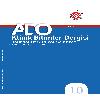ÇİFTLİK HAYVANLARINDA KAS LİFİ SINIFLANDIRMA METOTLARI
Histokimyasal boyama, Kas lifi, Sınıflandırma, Et kalitesi
Methods for Classifying Muscle Fibers in Farm Animals
Histochemical stains, Muscle fiber, Classifying, Meat quality,
___
- Ashmore CR, Doerr L (1971) Comparative aspects of muscle fiber types in different spcies. Experimental. Neurol 31: 431-438.
- Barnard RJ, Edgerton VR, Furukawa T, Peter JB (1971) Histochemical, biochemical and contractile properties of red, white and intermediate fibres. Am J Physiol 220: 410-414.
- Broke MM, Keiser K (1970) Muscle fiber type; How many and what kind? Arc Neurol 23: 369-370.
- Carnwath JW, Shotton DM (1987) Muscular dystrophy in the Mdx mouse: Histopathology of the soleus and extensor digitorum longus muscles. J Neurol Sci 80: 39-54.
- Carpenter CE, Rice OD, Cockett NE, Snowder GD (1996) Histology and composition of muscles from normal and callipyge lambs. J Anim Sci 74: 388-393.
- Cassens RG, Cooper CC (1971) Red and white muscle. Ado Food Res 19: 1-9.
- Dubowitz V, Pearse AGE (1960) Reciprocal relationships of phosphorylase and oxidative enzymes in skeletal muscle. Nature 185: 701-710.
- Klont RE, Brocks L, Eikelenboom G (1998) Muscle fiber type and meat quality. Meat Sci 49: 219-229.
- Kuran M, Şen U, Şirin E, Aksoy Y, Ulutaş Z (2008a) The effect of maternal feed intake during the peri- conception period on myogenesis in fetal sheep. Arch Tierz Dummers 51(SI): 18.
- Kuran M, Şen U, Şirin E, Aksoy Y (2008b) Level of maternal nutrition between day 30 and day 80 of pregnancy affects postnatal muscular development of offspring on day 150. In: Book of Abstracts of 59th Annual Meeting of EAAP, 14: 155.
- Kuran M, Şen U, Şirin E, Ulutaş Z (2012) Maternal undernutrition during mid-pregnancy affects muscle cellular characteristics of lambs. In: Book of Abstracts of 63th Annual Meeting of of EAAP, 18: 284.
- Kuran M, Ulutaş Z, Ocak N, Şirin E (2008c) Koyunlarda Ananın Beslenmesinin Kuzuların Post-Natal Kas Lifi Gelişimi ve Et Kalitesine Etkisi. TÜBİTAK-TBAG (105T277, TBAG-U/148) Proje Kesin Sonuç Raporu, Ankara.
- Maltin CA, Delday MI, Sinclair KD, Steven J, Sneddon AA (2001) Impact of manipulations of myogenesis in utero on the performance of adult skeletal muscle. Reprod 122: 359-374.
- Moddy WG, Cassens RG (1968) Histochemical differentiation of red and white muscle fibers. J Anim Sci 27: 961-969.
- Nissen PM, Danielsen VO, Jorgensen PF, Oksbjerg N (2003) Increased maternal nutrition of sows no beneficial effects on muscle fiber number or postnatal growth and has no impact on the meat quality of the offspring. J Anim Sci 81: 3018-3027.
- Nyström B (1968) Histochemistry of developing cat muscles. Acta Neurol Scand 44: 405-513.
- Pearson AM, Young RB (1989) Muscle and Meat Biochemistry. Academic Press, London.
- Peinado B, Latorre R, Vaquez-Auton JM, Poto A, Ramirez G, Lopez-Albors O, Moreno F, Gil F (2004) Histochemical Skeletal Muscle Fibre Types in the Sheep. Anat Histol Embryol 33: 236-243.
- Peter JB, Jefferss RN, Edgerton VR, Gillespie CA, Stempel KE (1972) Metabolic profiles of three fibers types of skeletal muscle in guinea pigs and rabbits. Biochem 11: 2627-2635.
- Picard B, Gagniere H, Geay Y (1996) Contractile differentiation of bovine masseter muscle. Basic Appl Myol 6: 361-372.
- Picard B, Lefaucheur L, Berri C (2002) Muscle fibre ontogenesis in farm animal species. Reprod Nutr Dev 42: 415-431.
- Rehfeldt C, Fiedler I, Dietl G, Ender K (2000) Myogenesis and postnatal skeletal muscle cell growth as influenced by selection. Livest Prod Sci 66: 177-188.
- Renand G, Picard B, Touraille C, Berge P, Lepetit J (2001) Relationship between muscle characteristics and meat quality traits of young Charolais bulls. Meat Sci 59: 49- 60.
- Salviati G, Betto R, Betto DD (1982) Polymorphism of myofibrillar proteins rabbits skeletal muscle fibers. An electrophoretic study of single fibers. Biochem J 207: 261-270.
- Şen U, Şirin E, Aksoy, Y., Ensoy, Ü., Ulutaş, Z., Kuran, M., 2015. The effect of maternal nutrition level during mid- gestation on post-natal muscle fiber composition and meat quality in lambs. Anim. Prod. Sci., DOI: 10.1071/AN14663.
- Şirin, E., Aksoy Y, Şen U, Ulutaş Z, Kuran M (2011) Kuzu doğum ağırlığının semitendinosus kasındaki lif sayısı ve çeşidine etkisi. Anadolu Tar Bil Derg 26: 63-67.
- Şirin E, Sayli Ö, Ulutaş Z, Şen U, Erdoğan SB, Aksoy Y, Akın A, Kuran M (2008) Can functional near infrared spectroscopy (fNIRS) be used for the estimation of the numbers and types of muscle fibres in sheep? Arch Tierz Dummers 51(SI): 45-46.
- Solomon MB, Moody WG, Kemp JP, Ely DG (1981) Effect of breed, slaughter weight and sex on histological properties of ovine muscle. J Anim Sci 52: 1019-1021.
- Stein JM, Padykula HA (1962) Histochemical classification of individual skeletal muscle fiber of rat. American J Anat 110: 103-109.
- Suzuki A (1971) Histochemical classification of individual skeletal muscle fibers in the sheep. I. On M. semitendinosus, M. Longissimus dorsi, M. psoas major, M. latissimus dorsi and M. gastrocnemius. Jap J Zootech Sci 42: 39-54.
- Valin C (1988) Differentiation tissues muscular. Consequences technologies pour filigree viand. Reprod Nutr Dev 28: 845-856.
- White NA, McGavin MD, Smith JD (1978) Age-related changes in percentage of fiber types and mean fiber diameters of the ovine quadriceps muscles. Am J Vet Res 39: 1297-1302.
- Yellin H (1969) A histochemical study of muscle spindles and their relationships to extrafusal fiber types in rat. Am Jour Anat 125: 31-42. Sorumlu Yazar Uğur ŞEN
- ugur.sen@ahievran.edu.tr
- Ahi Evran Üniversitesi, Ziraat Fakültesi,
- Tarımsal Biyoteknoloji Bölümü, 40100,
- Aşıkpaşa, Kırşehir Geliş Tarihi Kabul Tarihi : 07.10.2015
- ISSN: 1304-7787
- Yayın Aralığı: 2
- Başlangıç: 2004
- Yayıncı: Adnan Üniv. Ziraat Fak.
AYDIN BÖLGESİNDE PAMUKTA TOPRAKÜSTÜ VE TOPRAKALTI DAMLA SULAMA UYGULAMALARININ İRDELENMESİ
Yakup ÖZDEMİR, Necdet DAĞDELEN
DÜZCE YÖRESİ SU VE TOPRAK KAYNAKLARININ TARIMSAL YÖNDEN DEĞERLENDİRİLMESİ
Selçuk ÖZMEN, Merve YILDIRIM, Burhan ŞAHİN
DEVE GÜREŞİ Mİ, DEVE DÖVÜŞÜ MÜ?
KOYUNLARDA STRESLE İLGİLİ BAZI FİZYOLOJİK PARAMETRELERİN MEVSİMSEL DEĞİŞİMİ
ÇİFTLİK HAYVANLARINDA KAS LİFİ SINIFLANDIRMA METOTLARI
